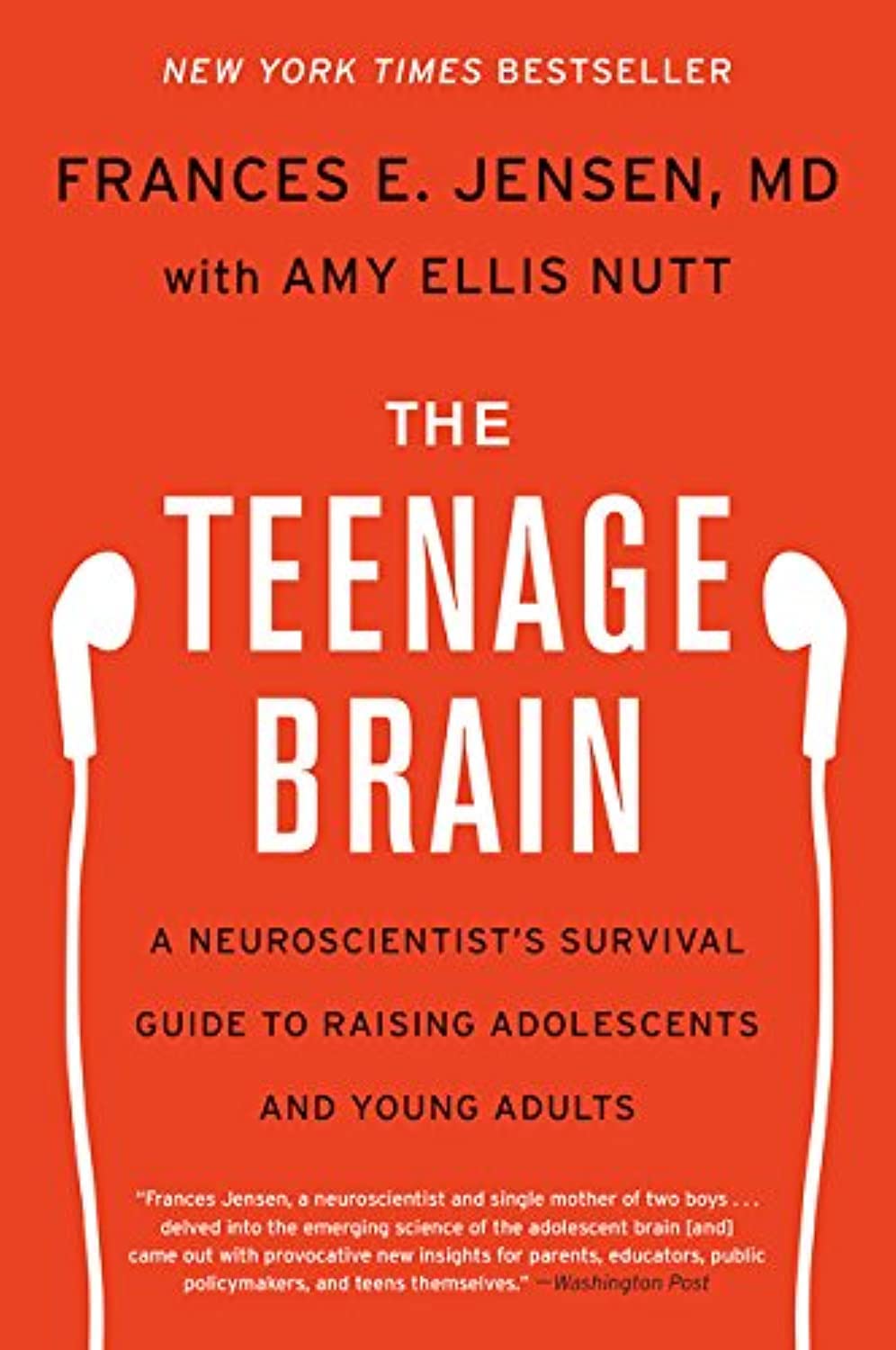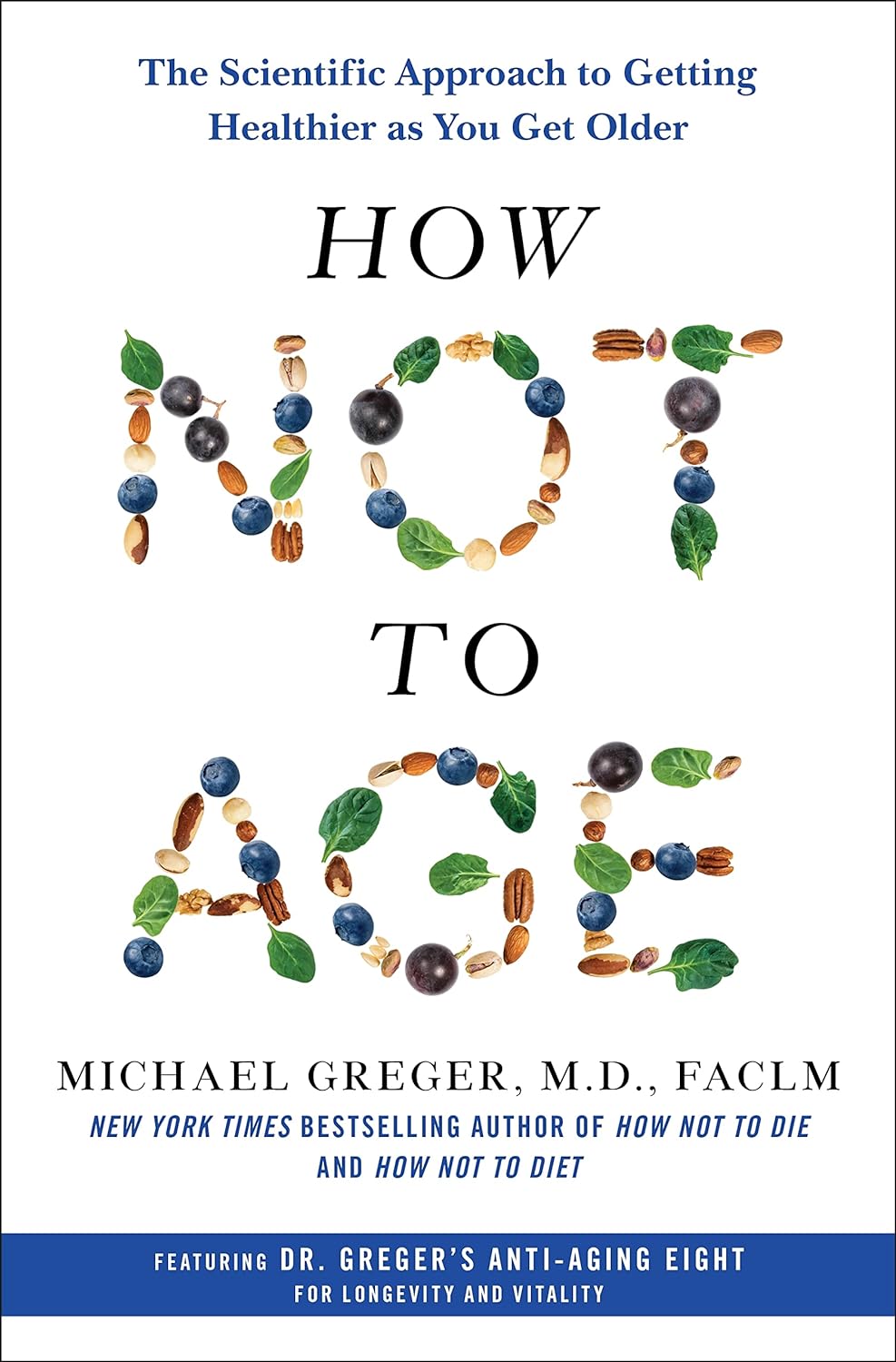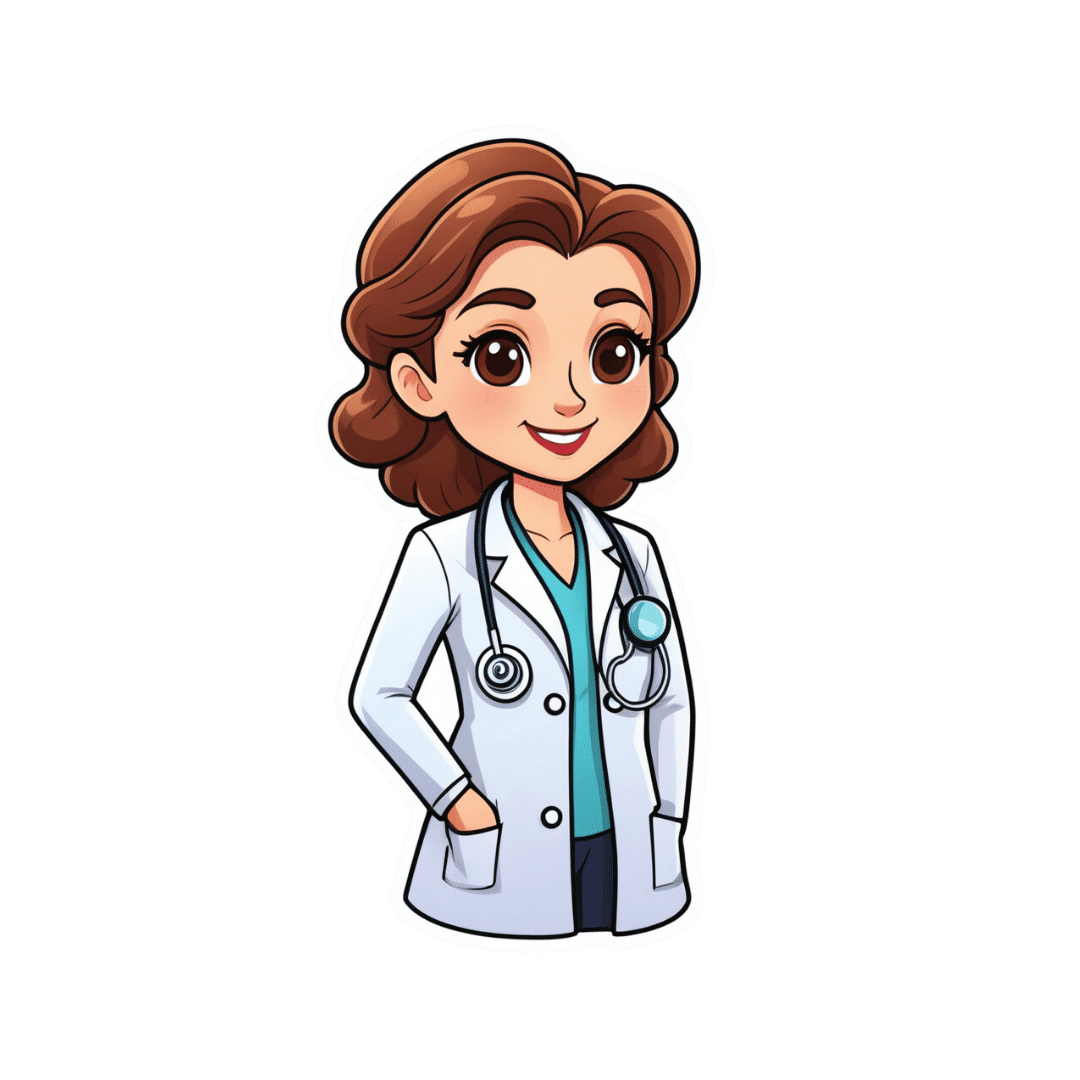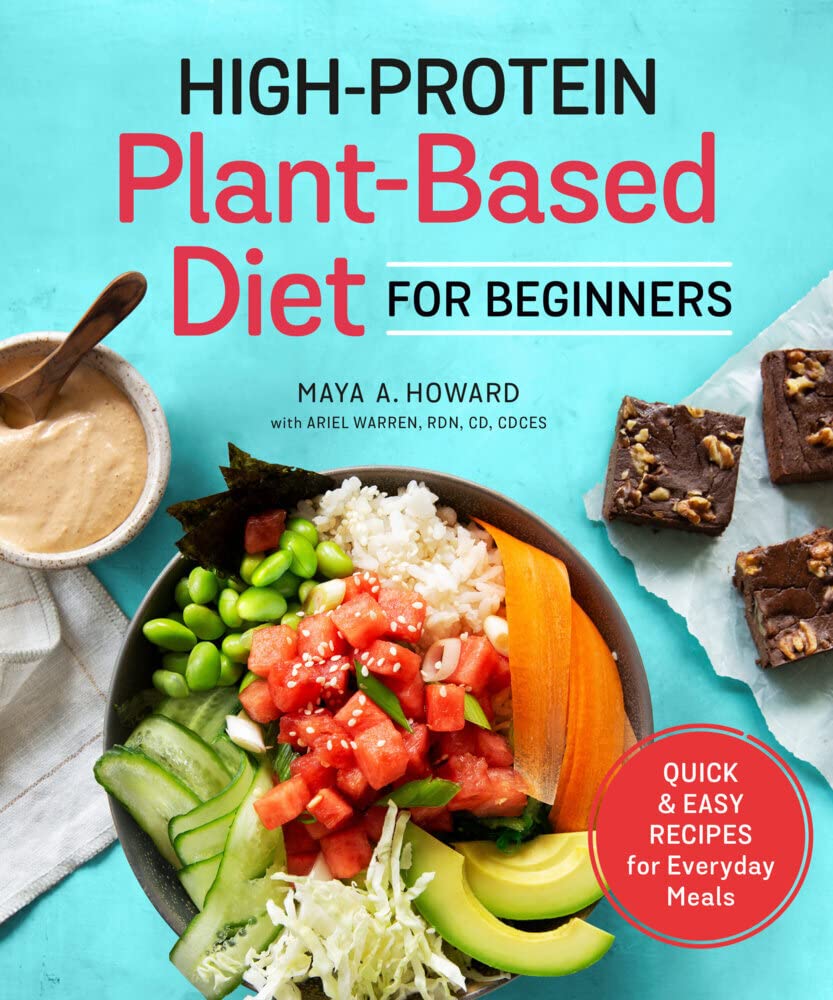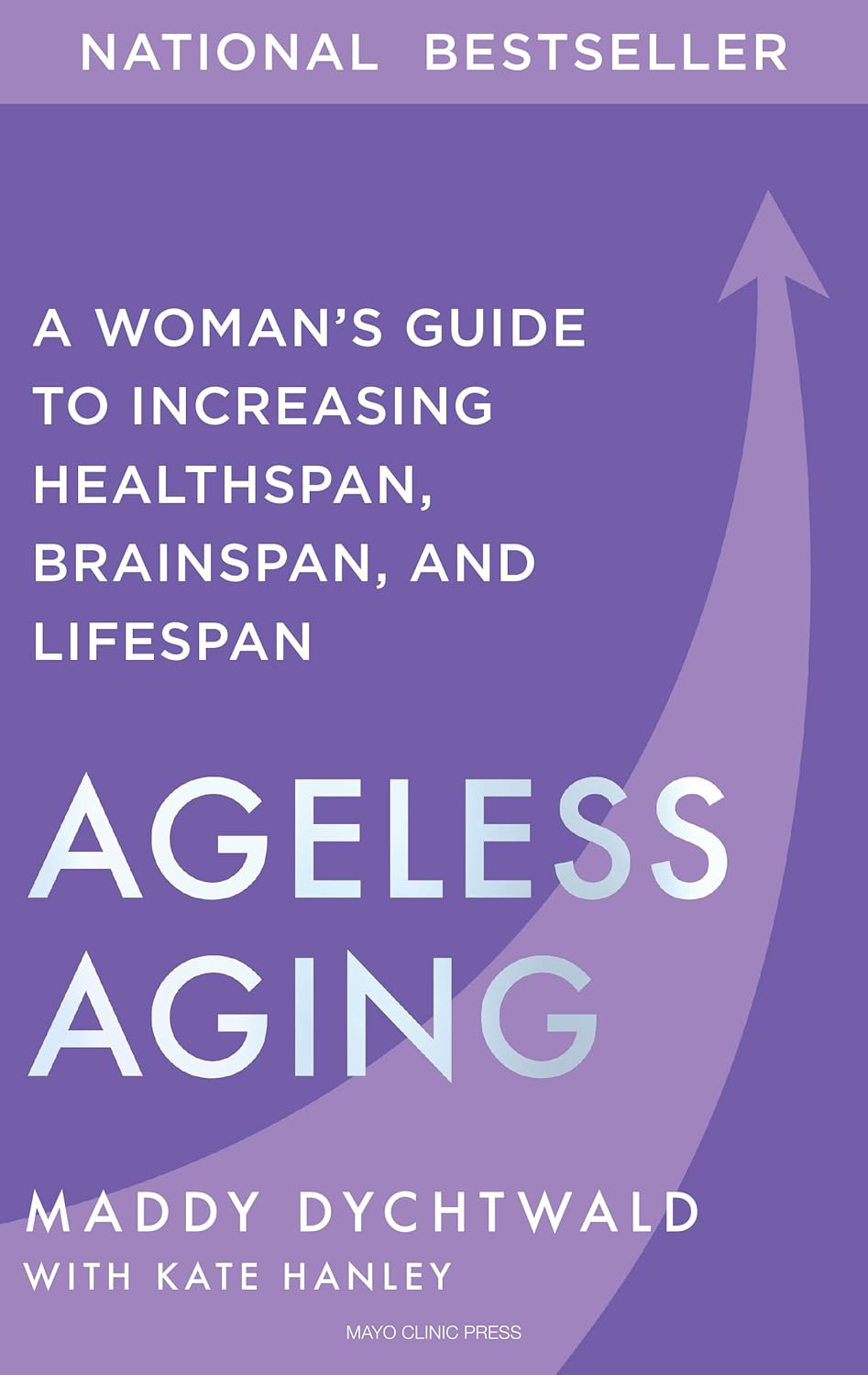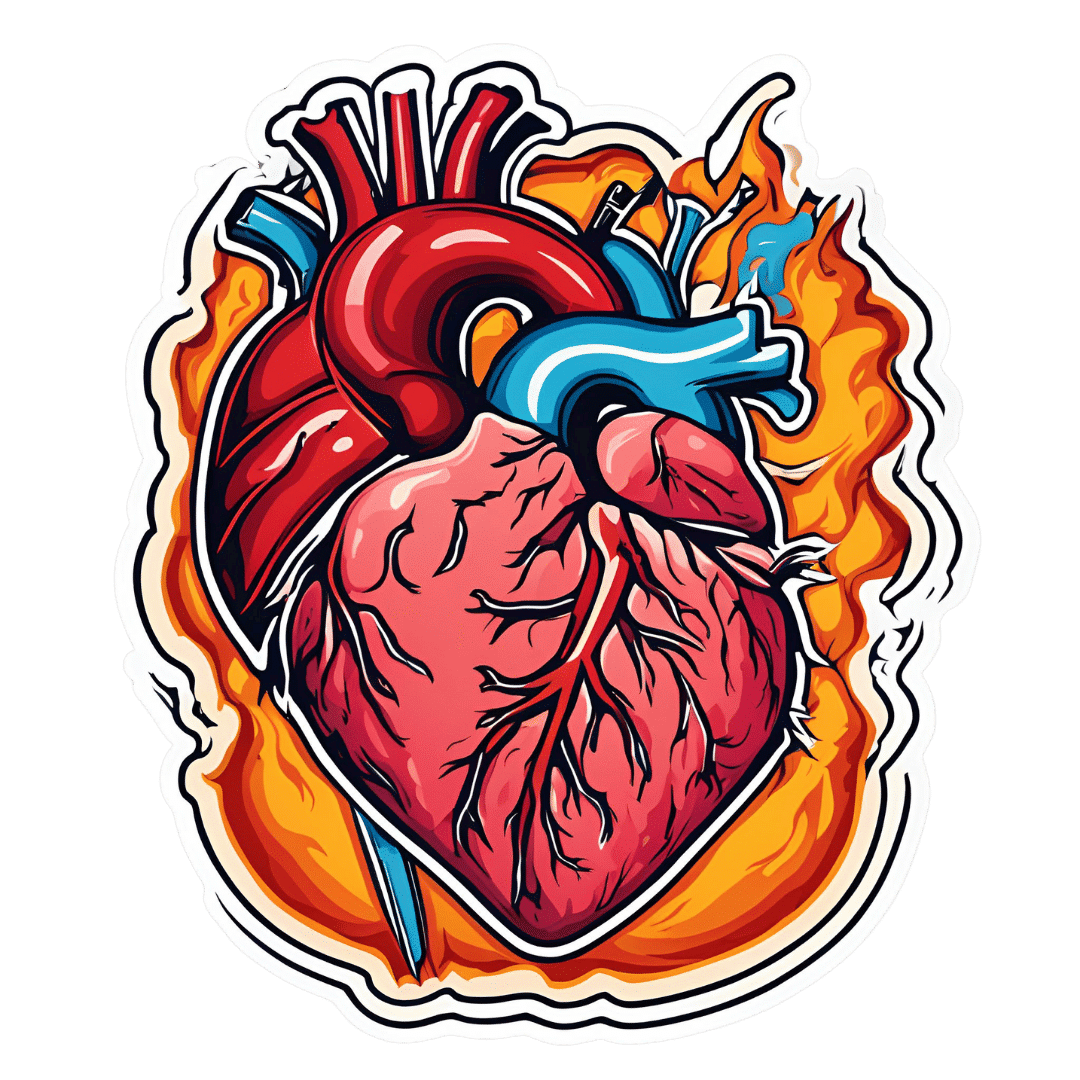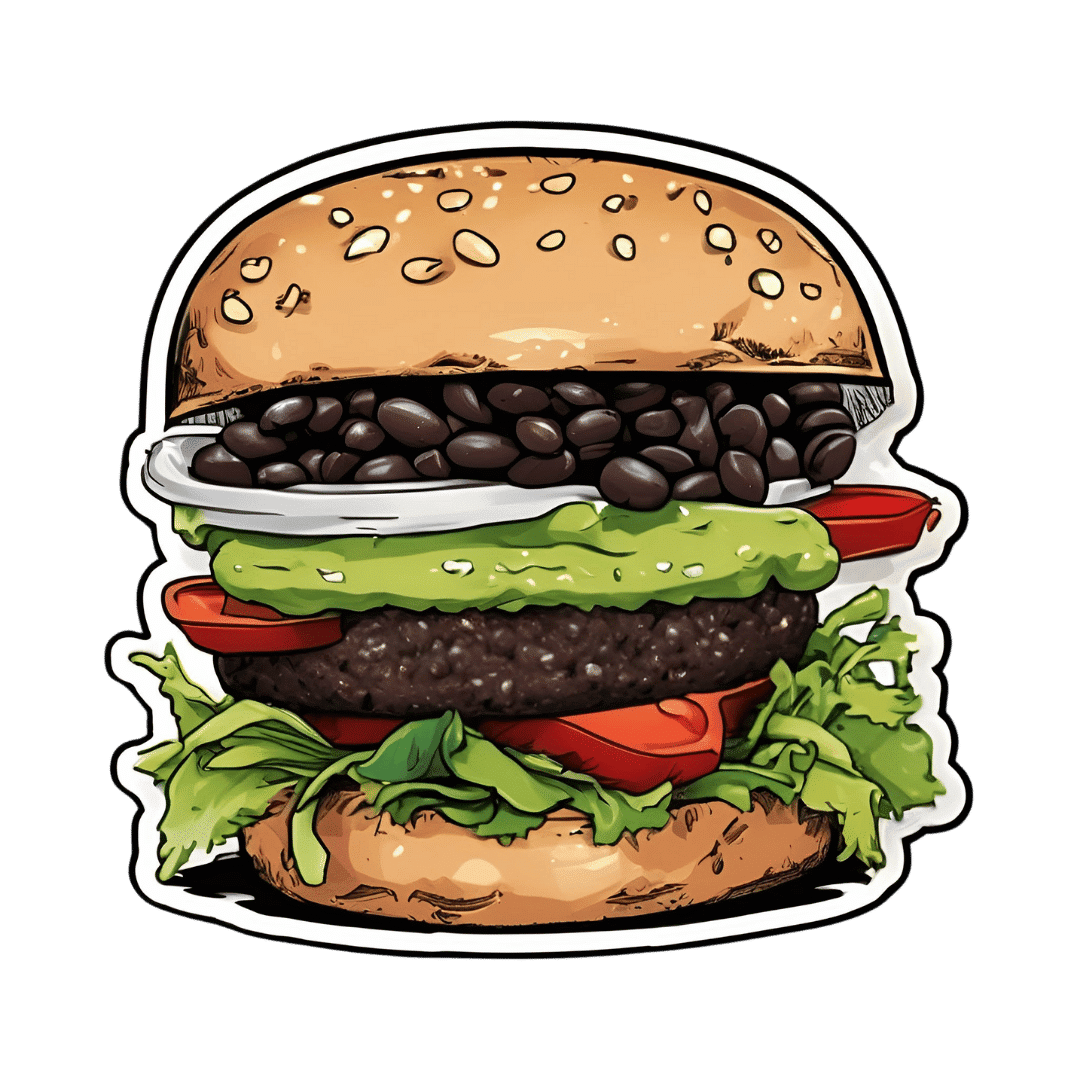
Black Bean Burgers With Guacamole
10almonds is reader-supported. We may, at no cost to you, receive a portion of sales if you purchase a product through a link in this article.
Once again proving that burgers do not have to be unhealthy, this one’s a nutritional powerhouse full of protein, fiber, vitamins, and minerals, as well as healthy fats and extra health-giving spices.
You will need
- 1 can black beans, drained and rinsed (or 1 cup same, cooked, drained, and rinsed)
- 3 oz walnuts (if allergic, substitute with pumpkin seeds)
- 1 tbsp chia seeds
- 1 tbsp flax seeds
- ½ red onion, finely chopped
- 1 small eggplant, diced small (e.g. ½” cubes or smaller)
- 1 small carrot, grated
- 3 tbsp finely chopped cilantro (or if you have the “this tastes like soap” gene, then substitute with parsley)
- 1 tbsp lemon juice
- 1 jalapeño pepper, finely chopped (adjust per heat preferences)
- ¼ bulb garlic, crushed
- 2 tsp black pepper
- 1 tsp smoked paprika
- 1 tsp cayenne pepper (adjust per heat preferences)
- ½ tsp MSG or 1 tsp low-sodium salt
- Burger buns (you can use our Delicious Quinoa Avocado Bread recipe if you like)
For the guacamole:
- 1 large ripe avocado, pitted, skinned, and chopped
- 1 tbsp lime juice
- 1 tomato, finely chopped
- ¼ red onion, finely chopped
- ¼ bulb garlic, crushed
- 1 tsp red chili pepper flakes (adjust per heat preferences)
Method
(we suggest you read everything at least once before doing anything)
1) Process the walnuts, chia seeds, and flax seeds in a food processor/blender, until they become a coarse mixture. Set aside.
2) Heat a little oil in a skillet, and fry the red onion, aubergine, and carrot for 5 minutes stirring frequently, then add the garlic and jalapeño and stir for a further 1 minute. Set aside.
3) Combine both mixtures you set aside with the rest of the ingredients from the burger section of the recipe, except the buns, and process them in the food processor on a low setting if possible, until you have a coarse mixture—you still want some texture, not a paste.
4) Shape into patties; this recipe gives for 4 large patties or 8 small ones. When you’ve done this, put them in the fridge for at least 30 minutes, to firm up.
5) While you wait, make the guacamole by mashing the avocado with the lime juice, and then stirring into the onion, tomato, garlic, and pepper.
6) Cook the patties; you can do this on the grill, in a skillet, or in the oven, per your preference. Grilling or frying should take about 5 minutes on each side, give or take the size and shape of the patties. Baking in the oven should take 20–30 minutes at 400℉ / 200℃ turning over halfway through, but keep an eye on them, because again, the size and shape of the patties will affect this. You may be wondering: aren’t they all going to be patty-shaped? And yes, but for example a wide flat patty will cook more quickly than the same volume of burger mixture in a taller less wide patty.
7) Assemble! We recommend the order: bottom bun, guacamole, burger patty, any additional toppings you want to add (e.g. more salad, pickles, etc), top bun:
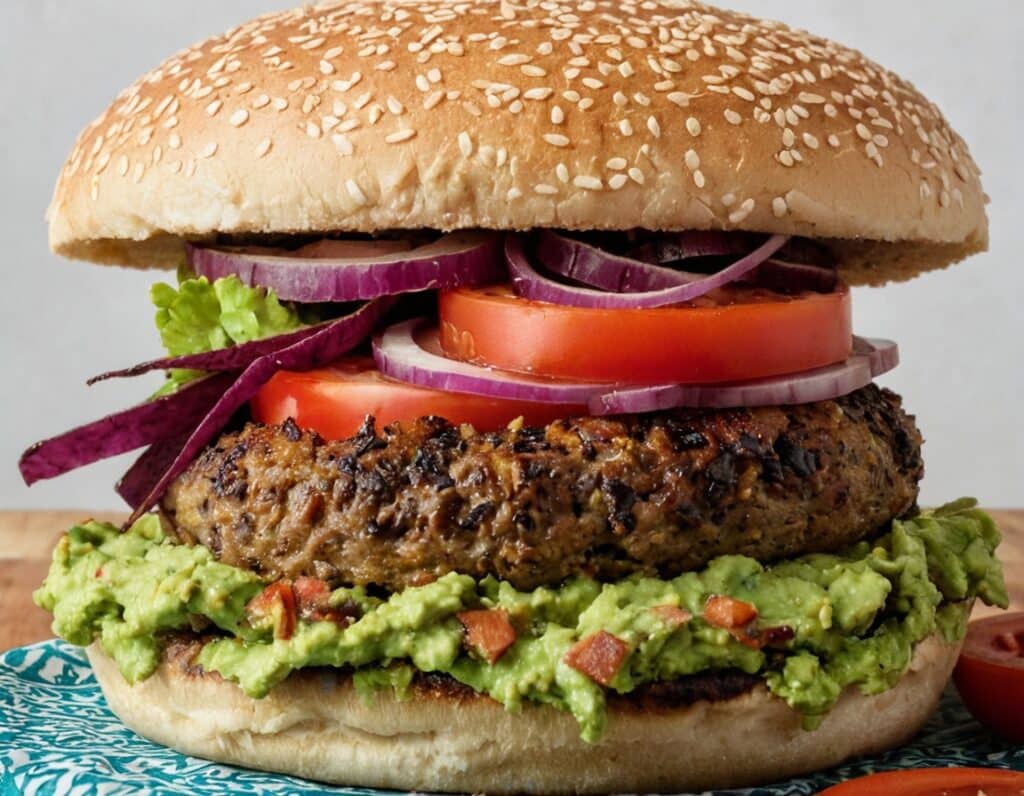
Enjoy!
Want to learn more?
For those interested in some of the science of what we have going on today:
- Level-Up Your Fiber Intake! (Without Difficulty Or Discomfort)
- Chickpeas vs Black Beans – Which is Healthier?
- Kidney Beans or Black Beans – Which is Healthier?
- Coconut vs Avocado – Which is Healthier?
- Our Top 5 Spices: How Much Is Enough For Benefits?
Take care!
Don’t Forget…
Did you arrive here from our newsletter? Don’t forget to return to the email to continue learning!
Recommended
Learn to Age Gracefully
Join the 98k+ American women taking control of their health & aging with our 100% free (and fun!) daily emails:
-
The Teenage Brain – by Dr. Frances Jensen
10almonds is reader-supported. We may, at no cost to you, receive a portion of sales if you purchase a product through a link in this article.
We realize that we probably have more grandparents of teenagers than parents of teenagers here, but most of us have at least some teenage relative(s). Which makes this book interesting.
There are a lot of myths about the teenage brain, and a lot of popular assumptions that usually have some basis in fact but are often misleading.
Dr. Jensen gives us a strong foundational grounding in the neurophysiology of adolescence, from the obvious-but-often-unclear (such as the role of hormones) to less-known things like the teenage brain’s general lack of myelination. Not just “heightened neuroplasticity” but, if you imagine the brain as an electrical machine, then think of myelin as the insulation between the wires. Little wonder some wires may get crossed sometimes!
She also talks about such things as the teenage circadian rhythm’s innate differences, the impact of success and failure on the brain, and harder topics such as addiction—and the adolescent cortisol functions that can lead to teenagers needing to seek something to relax in the first place.
In criticism, we can only say that sometimes the author makes sweeping generalizations without acknowledging such, but that doesn’t detract from what she has to say on the topic of neurophysiology.
Bottom line: if there’s a teenager in your life whose behavior and/or moods are sometimes baffling to you, and whose mysteries you’d like to unravel, this is a great book.
Click here to check out the Teenage Brain, and better understand those around you!
Share This Post
-
How Not to Age – by Dr. Michael Greger
10almonds is reader-supported. We may, at no cost to you, receive a portion of sales if you purchase a product through a link in this article.
First things first: it’s a great book, and it’s this reviewer’s favorite of Dr. Greger’s so far (for posterity: it’s just been published and this reviewer has just finished reading the copy she got on pre-order)
Unlike many popular physician authors, Dr. Greger doesn’t rehash a lot of old material, and instead favours prioritizing new material in each work. Where appropriate, he’ll send the reader to other books for more specific information (e.g: you want to know how to avoid premature death? Go read How Not To Die. You want to know how to lose weight? How Not To Diet. Etc).
In the category of new information, he has a lot to offer here. And with over 8,000 references, it’s information, not conjecture. On which note, we recommend the e-book version if that’s possible for you, for three reasons:
- It’s possible to just click the references and be taken straight to the cited paper itself online
- To try to keep the book’s size down, Dr. Greger has linked to other external resources too
- The only negative reviews on Amazon, so far, are people complaining that the print copy’s text is smaller than they’d like
For all its information-density (those 8,000+ references are packed into 600ish pages), the book is very readable even to a lay reader; the author is a very skilled writer.
As for the content, we can’t fit more than a few sentences here so forgive the brevity, but we’ll mention that he covers:
- Slowing 11 pathways of aging
- The optimal anti-aging regimen according to current best science
- Preserving function (specific individual aspects of aging, e.g. hearing, sight, cognitive function, sexual function, hair, bones, etc)
- “Dr. Greger’s Anti-Aging Eight”
In terms of “flavor” of anti-aging science, his approach can be summed up as: diet and lifestyle as foundation; specific supplements and interventions as cornerstones.
Bottom line: this is now the anti-aging book.
Click here to check out How Not To Age, and look after yourself with the best modern science!
Share This Post
-
New California Laws Target Medical Debt, AI Care Decisions, Detention Centers
10almonds is reader-supported. We may, at no cost to you, receive a portion of sales if you purchase a product through a link in this article.
SACRAMENTO, Calif. — As the nation braces for potential policy shifts under President-elect Donald Trump’s “Make America Healthy Again” mantra, the nation’s most populous state and largest health care market is preparing for a few changes of its own.
With supermajorities in both houses, Democrats in the California Legislature passed — and Democratic Gov. Gavin Newsom signed — laws taking effect this year that will erase medical debt from credit reports, allow public health officials to inspect immigrant detention centers, and require health insurance companies to cover fertility services such as in vitro fertilization.
Still, industry experts say it was a relatively quiet year for health policy in the Golden State, with more attention on a divisive presidential election and with several state legislators seeking to avoid controversial issues as they ran for Congress in competitive swing districts.
Newsom shot down some of legislators’ most ambitious health care policies, including proposals that would have regulated pharmaceutical industry middlemen and given the state more power to stop private equity deals in health care.
Health policy experts say advocates and legislators are now focused on how to defend progressive California policies such as sweeping abortion access in the state and health coverage for immigrants living in the U.S. without authorization.
“I think everyone’s just thinking about how we’re going to enter 2025,” said Rachel Linn Gish, a spokesperson with the consumer health advocacy group Health Access California. “We’re figuring out what is vulnerable, what we are exposed to on the federal side, and what do budget changes mean for our work. That’s kind of putting a cloud over everything.”
Here are some of the biggest new health care laws Californians should know about:
Medical debt
California becomes the eighth state in which medical debt will no longer affect patients’ credit reports or credit scores. SB 1061 bars health care providers and debt collectors from reporting unpaid medical bills to credit bureaus, a practice that supporters of the law say penalizes people for seeking critical care and can make it harder for patients to get a job, buy a car, or secure a mortgage.
Critics including the California Association of Collectors called the measure from Sen. Monique Limón (D-Santa Barbara) a “tremendous overreach” and successfully lobbied for amendments that limited the scope of the bill, including an exemption for any medical debt incurred on credit cards.
The Biden administration has finalized federal rules that would stop unpaid medical bills from affecting patients’ credit scores, but the fate of those changes remains unclear as Trump takes office.
Psychiatric hospital stays for violent offenders
Violent offenders with severe mental illness can now be held longer after a judge orders them released from a state mental hospital.
State officials and local law enforcement will now have 30 days to coordinate housing, medication, and behavioral health treatment for those parolees, giving them far more time than the five-day deadline previously in effect.
The bill drew overwhelming bipartisan support after a high-profile case in San Francisco in which a 61-year-old man was charged in the repeated stabbing of a bakery employee just days after his release from a state mental hospital. The bill’s author, Assembly member Matt Haney (D-San Francisco), called the previous five-day timeline “dangerously short.”
Cosmetics and ‘forever chemicals’
California was the first state to ban PFAS chemicals, also known as “forever chemicals,” in all cosmetics sold and manufactured within its borders. The synthetic compounds, found in everyday products including rain jackets, food packaging, lipstick, and shaving cream, have been linked to cancer, birth defects, and diminished immune function and have been increasingly detected in drinking water.
Industry representatives have argued that use of PFAS — perfluoroalkyl and polyfluoroalkyl substances — is critical in some products and that some can be safely used at certain levels.
Immigration detention facilities
After covid-19 outbreaks, contaminated water, and moldy food became the subjects of detainee complaints and lawsuits, state legislators gave local county health officials the authority to enter and inspect privately run immigrant detention centers. SB 1132, from Sen. María Elena Durazo (D-Los Angeles), gives public health officials the ability to evaluate whether privately run facilities are complying with state and local public health regulations regarding proper ventilation, basic mental and physical health care, and food safety.
Although the federal government regulates immigration, six federal detention centers in California are operated by the GEO Group. One of the country’s largest private prison contractors, GEO has faced a litany of complaints related to health and safety. Unlike public prisons and jails, which are inspected annually, these facilities would be inspected only as deemed necessary.
The contractor filed suit in October to stop implementation of the law, saying it unconstitutionally oversteps the federal government’s authority to regulate immigration detention centers. A hearing in the case is set for March 3, said Bethany Lesser, a spokesperson for California Attorney General Rob Bonta. The law took effect Jan. 1.
Doctors vs. insurance companies using AI
As major insurance companies increasingly use artificial intelligence as a tool to analyze patient claims and authorize some treatment, trade groups representing doctors are concerned that AI algorithms are driving an increase in denials for necessary care. Legislators unanimously agreed.
SB 1120 states that decisions about whether a treatment is medically necessary can be made only by licensed, qualified physicians or other health care providers who review a patient’s medical history and other records.
Sick leave and protected time off
Two new laws expand the circumstances under which California workers may use sick days and other leave. SB 1105 entitles farmworkers who work outdoors to take paid sick leave to avoid heat, smoke, or flooding when local or state officials declare an emergency.
AB 2499 expands the list of reasons employees may take paid sick days or use protected unpaid leave to include assisting a family member who is experiencing domestic violence or other violent crimes.
Prescription labels for the visually impaired
Starting this year, pharmacies will be required to provide drug labels and use instructions in Braille, large print, or audio for blind patients.
Advocates of the move said state law, which already required translated instructions in five languages for non-English speakers, has overlooked blind patients, making it difficult for them to monitor prescriptions and take the correct dosage.
Maternal mental health screenings
Health insurers will be required to bolster maternal mental health programs by mandating additional screenings to better detect perinatal depression, which affects 1 in 5 people who give birth in California, according to state data. Pregnant people will now undergo screenings at least once during pregnancy and then six weeks postpartum, with further screenings as providers deem necessary.
Penalties for threatening health care workers (abortion clinics)
With abortion care at the center of national policy fights, California is cracking down on those who threaten, post personal information about, or otherwise target providers or patients at clinics that perform abortions. Penalties for such behavior will increase under AB 2099, and offenders can face felony charges, up to three years in jail, and $50,000 in fines for repeat or violent offenses. Previously, state law classified many of those offenses as misdemeanors.
Insurance coverage for IVF
Starting in July, state-regulated health plans covering 50 employees or more would be required to cover fertility services under SB 729, passed and signed last year. Advocates have long fought for this benefit, which they say is essential care for many families who have trouble getting pregnant and would ensure LGBTQ+ couples aren’t required to pay more out-of-pocket costs than straight couples when starting a family.
In a signing statement, Newsom asked legislators to delay implementation of the law until 2026 as state officials consider whether to add infertility treatments to the list of benefits that insurance plans are required to cover.
It’s unclear whether legislators intend to address that this session, but a spokesperson for the governor said that Newsom “clearly stated his position on the need for an extension” and that he “will continue to work with the legislature” on the matter.
Plans under CalPERS, the California Public Employees’ Retirement System, would have to comply by July 2027.
This article was produced by KFF Health News, which publishes California Healthline, an editorially independent service of the California Health Care Foundation.
KFF Health News is a national newsroom that produces in-depth journalism about health issues and is one of the core operating programs at KFF—an independent source of health policy research, polling, and journalism. Learn more about KFF.
Subscribe to KFF Health News’ free Morning Briefing.
This article first appeared on KFF Health News and is republished here under a Creative Commons license.
Share This Post
Related Posts
-
High-Protein Plant-Based Diet for Beginners – by Maya Howard with Ariel Warren
10almonds is reader-supported. We may, at no cost to you, receive a portion of sales if you purchase a product through a link in this article.
Seasoned vegans (well-seasoned vegans?) will know that getting enough protein from a plant-based diet is really not the challenge that many think it is, but for those just embarking on cutting out the meat, it’s not useful to say “it’s easy!”; it’s useful to show how.
That’s what this book does. And not just by saying “these foods” and leaving people to wonder if they need to eat a pound of tofu each day to get their protein in. Instead, recipes. Enough for a 4-week meal plan, and the idea is that after a month of eating that way, it won’t be nearly so mysterious.
The recipes are very easy to execute, while still having plenty of flavor (which is what happens when one uses a lot of flavorsome main ingredients and then seasons them well too). The ingredients are not obscure, and you should be able to find everything easily in any medium-sized supermarket.
As for the well-roundedness of the diet, we’ll mention that the “with Ariel Warren” in the by-line means that while the book was principally authored by Maya Howard (who is, at time of writing, a nutritionist-in-training), she had input throughout from Ariel Warren (a Registered Dietician Nutritionist) to ensure she didn’t go off-piste anyway and it gets the professional stamp of approval.
Bottom line: if you’d like to cook plant based while still prioritizing protein and you’re not sure how to make that exciting and fun instead of a chore, then this book will show you how to please your taste buds and improve your body composition at the same time.
Click here to check out High-Protein Plant-Based Diet for Beginners, and dig in!
Don’t Forget…
Did you arrive here from our newsletter? Don’t forget to return to the email to continue learning!
Learn to Age Gracefully
Join the 98k+ American women taking control of their health & aging with our 100% free (and fun!) daily emails:
-
Ageless Aging – by Maddy Dychtwald
10almonds is reader-supported. We may, at no cost to you, receive a portion of sales if you purchase a product through a link in this article.
Maddy Dychtwald, herself 73, has spent her career working in the field of aging. She’s not a gerontologist or even a doctor, but she’s nevertheless been up-to-the-ears in the industry for decades, mostly as an organizer, strategist, facilitator, and so forth. As such, she’s had her finger on the pulse of the healthy longevity movement for a long time.
This book was written to address a problem, and the problem is: lifespan is increasing (especially for women), but healthspan has not been keeping up the pace.
In other words: people (especially women) are living longer, but often with more health problems along the way than before.
And mostly, it’s for lack of information (or sometimes: too much competing incorrect information).
Fortunately, information is something that a woman in Dychtwald’s position has an abundance of, because she has researchers and academics in many fields on speed-dial and happy to answer her questions (we get a lot of input from such experts throughout the book—which is why this book is so science-based, despite the author not being a scientist).
The book answers a lot of important questions beyond the obvious “what diet/exercise/sleep/supplements/etc are best for healthy aging” (spoiler: it’s quite consistent with the things we recommend here, because guess what, science is science), questions like how best to prepare for this that or the other, how to get a head start on preventative healthcare for some things, how to avoid being a burden to our families (one can argue that families are supposed to look after each other, but still, it’s a legitimate worry for many, and understandably so), and even how to balance the sometimes conflicting worlds of health and finances.
Unlike many authors, she also talks about the different kinds of aging, and tackles each of them separately and together. We love to see it!
Bottom line: this book is a very good one-stop-shop for all things healthy aging. It’s aimed squarely at women, but most advice goes for men the same too, aside from the section on hormones and such.
Click here to check out Ageless Aging, and plan your future!
Don’t Forget…
Did you arrive here from our newsletter? Don’t forget to return to the email to continue learning!
Learn to Age Gracefully
Join the 98k+ American women taking control of their health & aging with our 100% free (and fun!) daily emails:
-
How To Survive A Heart Attack When You’re Alone
10almonds is reader-supported. We may, at no cost to you, receive a portion of sales if you purchase a product through a link in this article.
Dr. Alan Mandel emphasizes the importance of staying calm and following these steps to improve survival chances:
Simple is best
Here’s how you will survive a heart attack alone: briefly.
So, you will need to get help as quickly as possible. 90% of people who make it to a hospital alive, go on to survive their heart attack, so that’s your top priority.
Call emergency services as soon as you suspect you are having a heart attack. Stay on the line, and stay calm.
While having a heart attack is not an experience that’s very conducive to relaxation, heightened emotions will exacerbate things, so focus on breathing calmly. One of the commonly reported symptoms of heart attack that doesn’t often make it to official lists is “a strong sense of impending doom”, and that is actually helpful as it helps separate it from “is this indigestion?” or such, but once you have acknowledged “yes, this is probably a heart attack”, you need to put those feelings aside for later.
If you have aspirin available, Dr. Mandel says that the time to take it is once you have called an ambulance. However, if aspirin is not readily available, do not exert yourself trying to find some; indeed, don’t move more than necessary.
Do not drive yourself to hospital; it will increase the risk of fainting, and you may crash.
While you are waiting, your main job is to remain calm; he recommends deep breathing, and lying with knees elevated or feet on a chair; this latter is to minimize the strain on your heart.
For more on all this, plus the key symptoms and risk factors, enjoy:
Click Here If The Embedded Video Doesn’t Load Automatically!
Want to learn more?
You might also like to read:
Heart Attack: His & Hers (Be Prepared!)
Take care!
Don’t Forget…
Did you arrive here from our newsletter? Don’t forget to return to the email to continue learning!
Learn to Age Gracefully
Join the 98k+ American women taking control of their health & aging with our 100% free (and fun!) daily emails:


